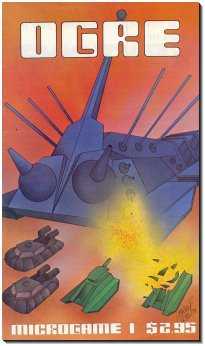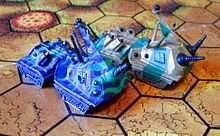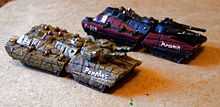Ogre (game)

Ogre is a board wargame first released in 1977 as the first Metagaming Concepts Microgame, designed by Steve Jackson.[1] Its basic premise is that it is an asymmetric-forces game[2] set in the late 21st century.[3] One player has a single giant robot tank (called an "Ogre") pitted against a second player's headquarters, defended by a mixture of conventional tanks, infantry, and artillery.[1][3] The concept was strongly influenced by Keith Laumer's novel Bolo (1976),[1] and Colin Kapp's short story "Gottlos" (1969).[4] The Ogre itself is named after the large and strong mythological beast ogre.
Since its initial release in 1977 Ogre has been reprinted many times, most recently in 2000.[5][6] After Jackson founded his own company, Steve Jackson Games, Ogre, its sequel G.E.V., and further expansions were published in the Pocket Box format.[6] On March 8, 2008, Steve Jackson Games announced the planned production of Ogre 6th Edition.[7] In 2012, a new version of Ogre successfully completed funding on Kickstarter.com, for release in November 2012.[8] After multiple delays, the elaborate 29 pound Designer's edition was shipped to all Kickstarter backers in November 2013.[9]
Game description
| “ | Gameplay summons to mind a futuristic nightmare of desperation and exhilaration, where rumbling machines unleash barrage after barrage of titanic weaponry and the inexorable advance of a soulless giant can only be stopped by zinging swarms of self-sacrificing martyrs. | ” |
| —Erick Wujcik [2] | ||
Ogre uses a hex map depicting barren terrain with only ridgelines and large, radioactive craters as obstacles. The defender sets up his forces in the more congested part of the map and the Ogre enters the opposite side at the beginning of the game.[10] The basic version of the game has the attacker using a single Ogre heavy tank (referred to as a "Mark III Ogre"), while the advanced scenario gives the attacker the larger, more powerful "Mark V Ogre" tank versus an increased number of defenders.[1] The defender is allocated a certain number of infantry and 'armor units', but gets to decide the exact composition of his own armored forces.[2]
The different types of units encourage a combined-arms approach with each type being better than the others in different aspects.[11] Heavy tanks have high attack and defense with moderate speed and low range. Missile tanks have moderate attack and defense with moderate range and low speed.[11] G.E.V.s ("ground effect vehicles"—roughly, heavily armored hovercraft[1]) have very high speed (moving twice per turn),[2] low attack, low range, and moderate defense. Howitzers have very high attack and range[12] but are easily destroyed (once an attacker has managed to get close enough), immobile, and expensive.[2] However, according to the game's designer, this balanced mix of units wasn't quite right in the first edition; the second edition sped up heavy tanks, slowed down G.E.V.s, and changed the defender's purchasing from 'attack factors' to 'armor units' (everything is considered equivalent, except howitzers, which are worth two of anything else).[13]
Critical reception
Martin Easterbrook began his 1977 review of Ogre (first edition) by saying "Be warned: this game could become a craze" adding that "the idea of the microgames themselves is remarkable enough in itself." He rated the game 8 out of 10 but criticized the game's title and "flimsy equipment, weak infantry".[1]
Reviewing the first Steve Jackson Games editions of Ogre (after the designer had moved away from Metagaming), Tony Watson called Ogre "a legend in the ranks of SF gamedom, and deservedly so... as well as being a lot of fun to play, it's an interesting extrapolation on high-tech armoured warfare". It was noted that the rules had remained essentially the same in the new edition, and the most significant changes being to the physical design - with larger (still black and white) counters, and full colour maps by Denis Loubet. Watson also welcomed the retention of the original artwork alongside new pieces - "no one draws a GEV or Ogre like Mr. Chung."[14]
Reviewing the combined edition of 1991, Allen Varney stated: "[Ogre and GEV :] two simulation board games of armored combat on a future battlefield are among the best the field has ever seen: fast, elegant, and endlessly replayable." Whilst praising the production values of the 2-color playing pieces Varney found the box somewhat 'flimsy'.[15]
In his 2007 essay, game designer Erick Wujcik said "I think [Ogre's] success really boils down to four essentials: Ogre is fast, ... asymmetrical, ... open-ended, ... [and] is a teaching tool. Ogre had restructured my mind pretty completely ... but it wasn't until 2002 ... that I realized how effective Ogre is at getting across so many important component mechanisms of play and design."[2]
Editions

The first and second editions of Ogre were released in 1977. The first edition featured artwork by Winchell Chung, while the second had a much larger print run and rulebook artwork by Clark Bradly rather than Chung.[6] The third edition, released in 1982, introduced double-sided counters.
An edition called OGRE: Deluxe Edition was released in 1987. The rulebook cover artwork was the Denis Loubet illustration that was also used for the Ogre computer game (see Spinoffs below). The board was sturdier than the previous edition's paper map, and the counters were provided with stand-up plastic bases.[6][16] G.M. magazine's 1989 review of OGRE: Deluxe Edition highlighted the game's ease of introduction and short playing time, but pointed out that most gamers either like the game or loathe it.[16]
A "new" Deluxe Ogre (2000) was a re-issued version of the original Ogre, packaged with miniatures rather than counters, and the original 'crater' map printed on a larger scale.[17] Deluxe Ogre won the Wargamer Award for Excellence in 2001.[3]
In 2011 Steve Jackson announced a sixth edition, The Ogre Designer's Edition, combining OGRE and GEV with larger full color flat counters for most units and constructable cardboard figures for the Ogres.[18]
Kickstarter Project
In May 2012, a new designers edition of Ogre was funded on Kickstarter.com.[19] The original goal was $20,000 and the final funding was a total of $923,680. As the funding grew, more and more options and upgrades were added, with the final game weighing over 25 pounds (11 kg).[8] It began shipping to its Kickstarter supporters in October 2013, and is expected to arrive at retail stores on December 6, 2013.[20]
Spinoffs

Ogre spawned a sequel,[5] G.E.V., focusing on the G.E.V. hovertank and the other "conventional" armor and infantry types. G.E.V. introduced more realistic map terrain rules than Ogre's "clear land and craters" system, as well as rules for overrun combat, spillover fire, and cover.[21] It also introduced a points-based victory condition system which made possible a variety of symmetrical and asymmetrical scenarios. (G.E.V. had specifications for an Ogre tank unit, the Mk IV, and had rules detailing interactions of Ogres with the new rules in G.E.V.[22])
Other games based on Ogre include:
- Shockwave, an expansion that introduced new unit types including cruise missiles and a map that could be used with the G.E.V. map.[23]
- Ogre Miniatures, an adaptation of the game to miniature wargaming, using 1:285 scale miniatures.[24] This adaptation won the 1992 Origins Award for Best Miniatures Rules.[25] In addition to miniatures from Steve Jackson Games, a set of Ogre miniatures was also developed by Ral Partha which won the 1992 Origins Award for Best Vehicular Miniatures Series.[25] The first set of Ogre miniatures, produced by Martian Metals under license of Metagaming Concepts in 1979,[17] won the H.G. Wells Award for Best Vehicular Model Series of 1979.[26]
- Diceland: Ogre, a paper dice game by Cheapass Games.[27]
- Computer adaptations, including the 1986 release by Origin Systems, Inc. for Apple II, Amiga, Atari 8-bit, Atari ST, Commodore 64, DOS, and Macintosh,<ref name=""antic>Stanoch, John (August 1987). "Ogre". Antic (Review) 6 (4): 27.</ref>[28] ranked 130 in Computer Gaming World's 1996 list of 150 Best Games of All Time.[29]
Books
The OGRE Book (1982) was a collection of articles and rules variants from The Space Gamer. It was reissued in 2001, expanded from 40 pages to 128 with further retrospective from Steve Jackson.[6]
GURPS Ogre (2000) was a supplement for the role-playing game GURPS.[30][31]
References
- ↑ 1.0 1.1 1.2 1.3 1.4 1.5 Easterbrook, Martin (Aug–Sept 1977). "Open Box: Ogre". White Dwarf (Games Workshop) (#2): 12.
- ↑ 2.0 2.1 2.2 2.3 2.4 2.5 Wujcik, Erick (2007). "Ogre". In Lowder, James. Hobby Games: The 100 Best. Green Ronin Publishing. pp. 220–223. ISBN 978-1-932442-96-0.
- ↑ 3.0 3.1 3.2 Zabek, Jim. "Review: Deluxe OGRE". The Wargamer. Archived from the original on 2002-01-24.
- ↑ "Ogre FAQ". Steve Jackson Games.
- ↑ 5.0 5.1 Skucas, J. Michael (2000-05-16). "Ogre/G.E.V. (Review)". RPGnet. Retrieved 2008-03-24.
- ↑ 6.0 6.1 6.2 6.3 6.4 "Ogre Ludography". Steve Jackson Games. Retrieved 2008-03-24.
- ↑ "Bad MQ News, Good Ogre News". Steve Jackson Games. Retrieved 2013-11-22.
- ↑ 8.0 8.1 "Ogre Designer's Edition". Kickstarter.
- ↑ "All Shipped!". Steve Jackson Games. Retrieved 2013-11-22.
- ↑ Kirk, Robert C. (1977). "Ogre: A Review". The Space Gamer (Metagaming Concepts) #11.
- ↑ 11.0 11.1 Nahas, Michael (1982). "Basic Ogre Defence". The Space Gamer (Steve Jackson Games) #52.
- ↑ Hendrix, Chester (1979). "The Four Howitzer Defense in Ogre". The Space Gamer (Metagaming Concepts) #24.
- ↑ Jackson, Steve (1977). "Another ^@**&?!! Ogre Article". The Space Gamer (Metagaming Concepts) #12.
- ↑ Watson, Tony (August 1982). "Ogre roars back onto the scene". Dragon (64): 69–70.
- ↑ Varney, Allen (August 1991). "Role-playing reviews". Dragon (172): 64.
- ↑ 16.0 16.1 Razor, Johnny (April 1989). "OGRE: Deluxe Edition". G.M. 1 (8): 26.
- ↑ 17.0 17.1 "Ogre Miniatures - Collector's Checklist". Retrieved 2008-05-01.
- ↑ Jackson, Steve. "Open (Ogre) Letter To Distributors." Daily Ill., 12 March 2011.
- ↑ James, Geoffrey (May 8, 2012). "Crowdfunding Lessons From a Kickstarter Success". Inc.com.
- ↑
- ↑ Berke, Al. "Deluxe G.E.V. (review)" (– Scholar search). The Wargamer. Archived from the original on December 3, 2007. Retrieved 2008-03-24.
- ↑ Jackson, Steve (1978). "G.E.V. - A Designer's Introduction". The Space Gamer (Metagaming Concepts) #17.
- ↑ O'Hara, Walt (2001-04-16). "OGRE/GEV SHOCKWAVE game expansion". RPGnet. Retrieved 2008-03-12.
- ↑ Steve Jackson Games Miniatures
- ↑ 25.0 25.1 "Origins Award Winners (1992)". Academy of Adventure Gaming Arts & Design. Archived from the original on April 15, 2008. Retrieved 2008-02-27.
- ↑ "Origins Award Winners (1979)". Academy of Adventure Gaming Arts & Design. Archived from the original on April 15, 2008. Retrieved 2008-03-14.
- ↑ Appelcline, Shannon (2004-04-07). "Review of Diceland: Ogre". RPGnet. Retrieved 2008-02-19.
- ↑ "Release Information for Ogre". MobyGames. Retrieved 2008-02-27.
- ↑ "150 Best Games of All Time" (Article). Computer Gaming World 1 (148). November 1996.
- ↑ Day, Royce (2000-08-09). "GURPS Ogre (Review)". RPGnet. Retrieved 2008-02-19.
- ↑ Rhode, David (2001-05-07). "GURPS Ogre (Review)". RPGnet. Retrieved 2008-02-19.
External links
- Steve Jackson Games' Ogre page
- Ogre at BoardGameGeek
- Ogre at MobyGames
- Ogre Kickstarter Project page
- Winchell Chung Ogre artwork
- Ogre Designer's Edition